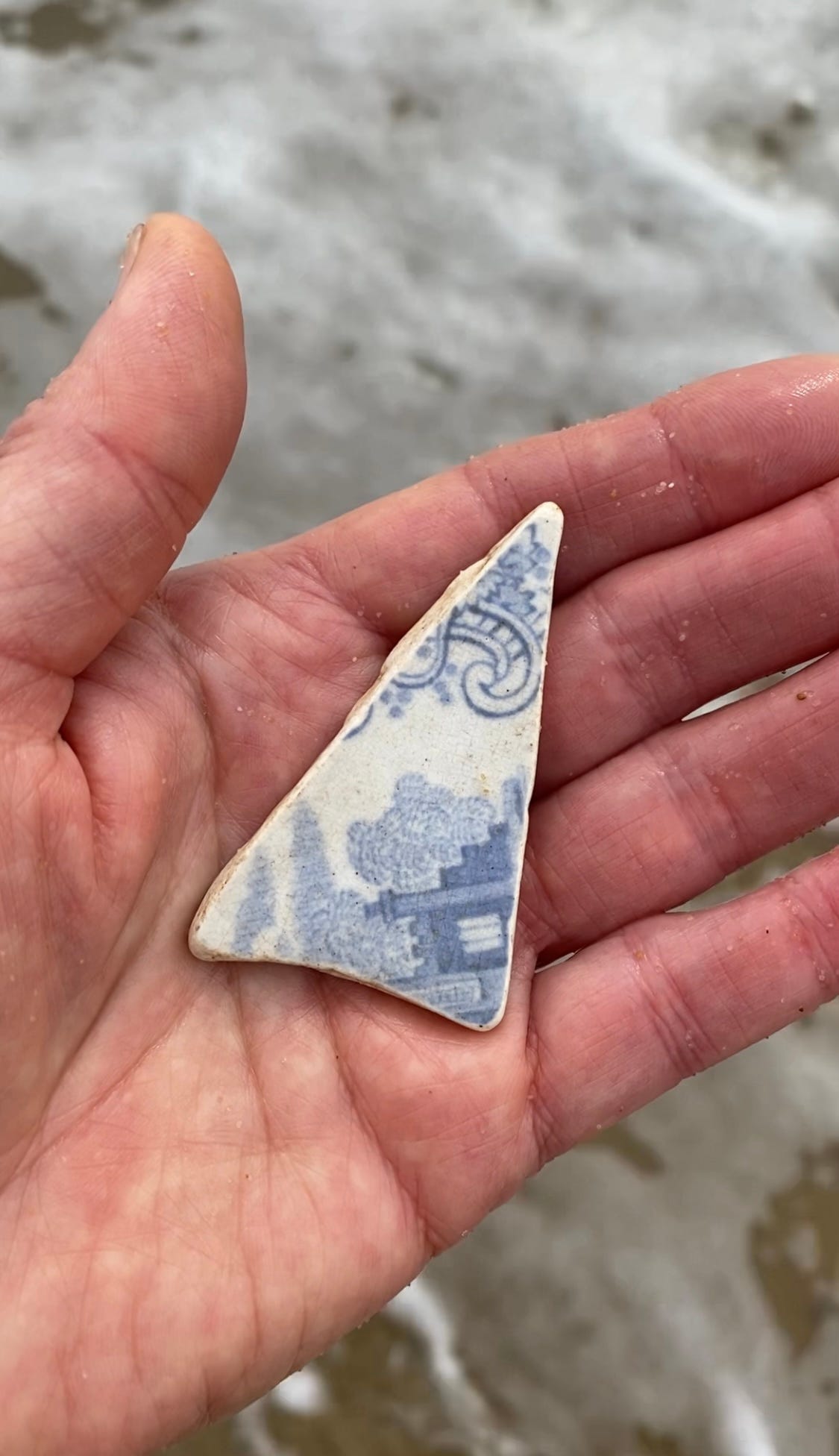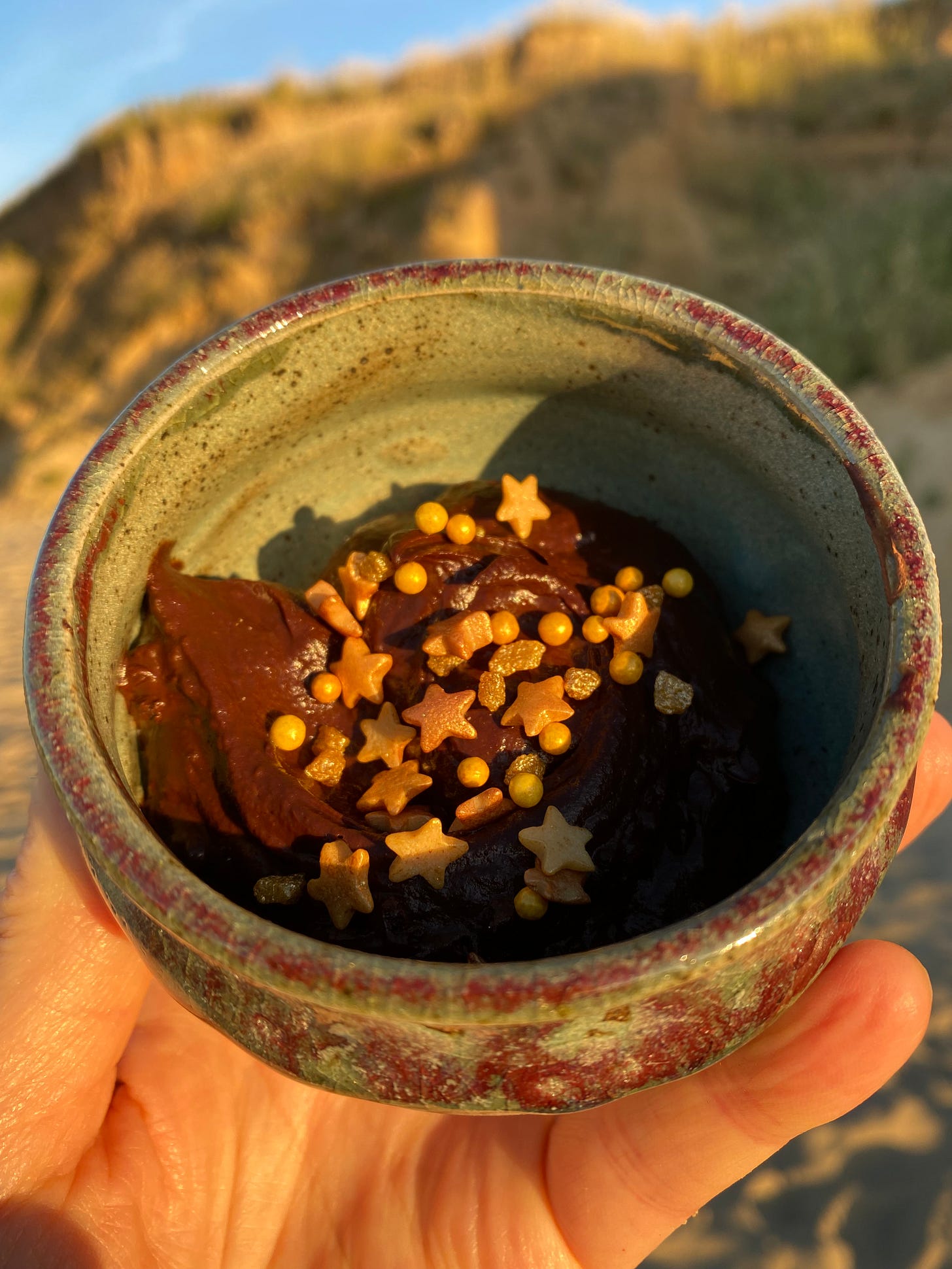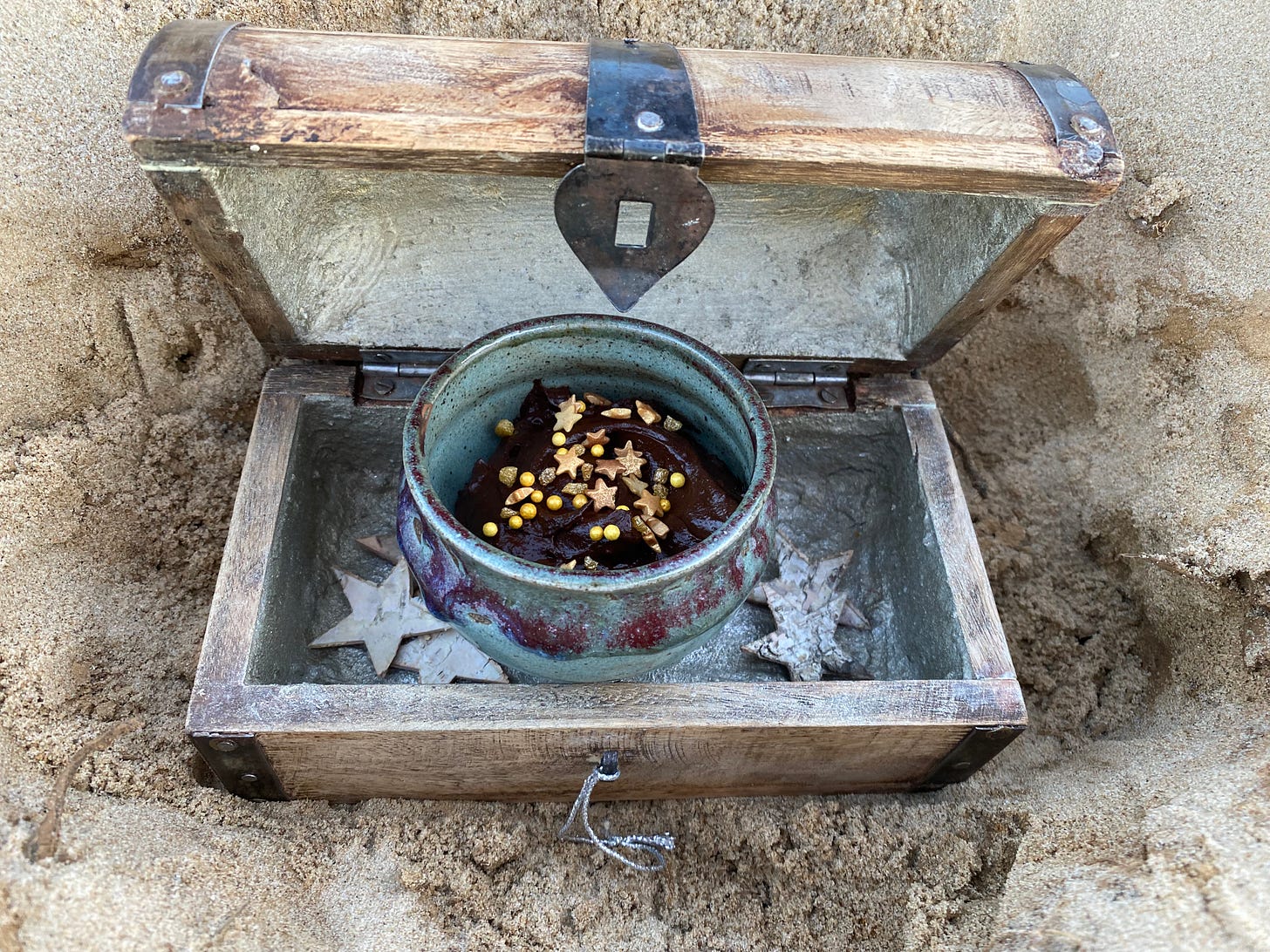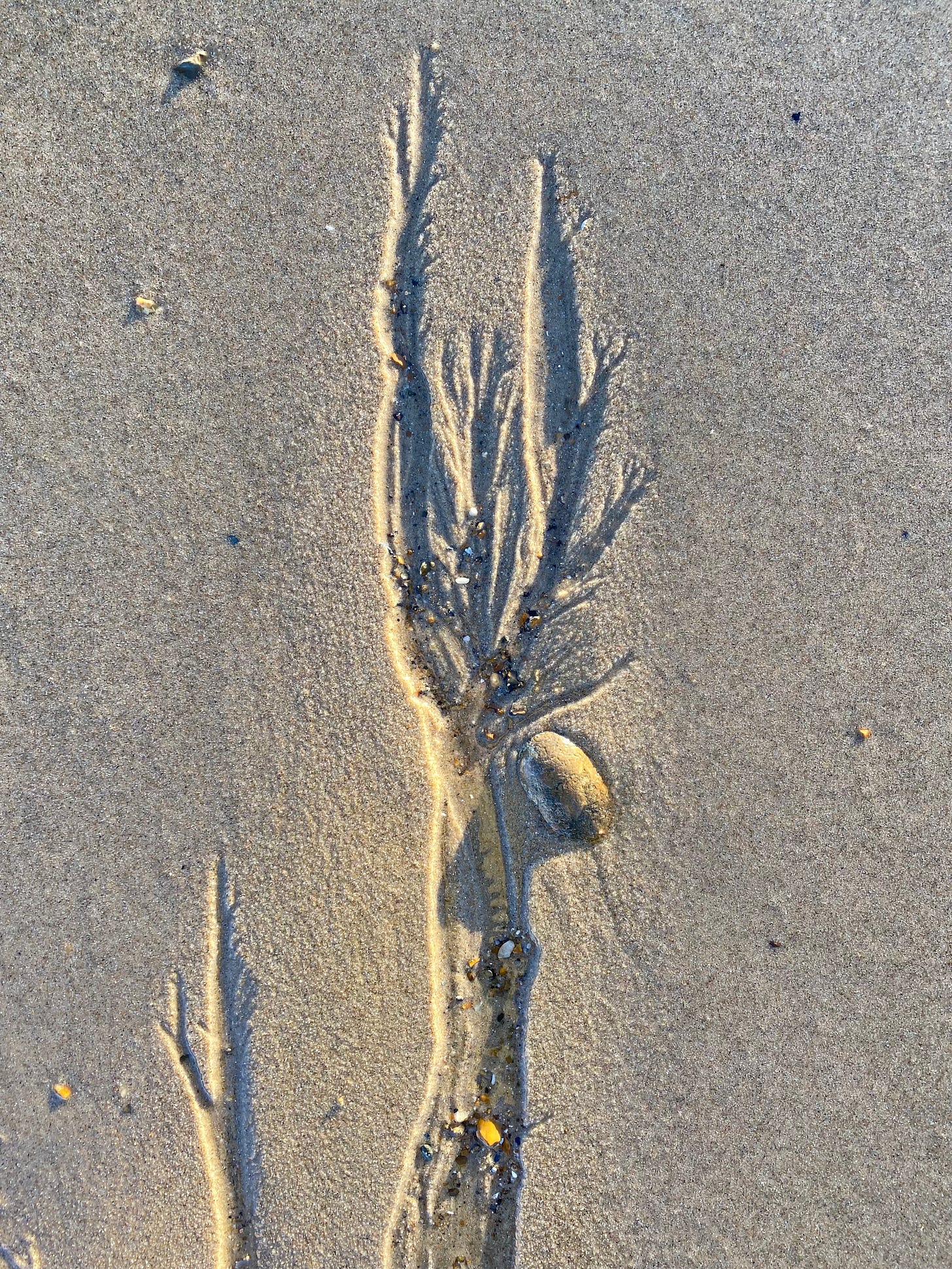The Fragile Edge
ghost-brides & fairy spears
Infant blackberries along the lane, 13 July 2023
I went out to the hazel wood,
Because a fire was in my head,
And cut and peeled a hazel wand,
And hooked a berry to a thread;
And when white moths were on the wing,
And moth-like stars were flickering out,
I dropped the berry in a stream
And caught a little silver trout.
When I had laid it on the floor
I went to blow the fire aflame,
But something rustled on the floor,
And someone called me by my name:
It had become a glimmering girl
With apple blossom in her hair
Who called me by my name and ran
And faded through the brightening air.
Though I am old with wandering
Through hollow lands and hilly lands
I will find out where she has gone,
And kiss her lips and take her hands;
And walk among long dappled grass,
And pluck till time and times are done
The silver apples of the moon,
The golden apples of the sun.
W B Yeats, The Song of Wandering Aengus
Happy New Moon in Cancer, friends!
A walk along the lane. A warm sunny blue sky day, as it has been since 5.30am when first I opened my eyes and dozed off again.
The sloes seem twice the size of last year’s, if not three times. But there are far fewer of them. I imagine the bushes know exactly what adjustments to make each season. All that remains is to transform their fruit from bruise-green to blackcurrant wine which I know they will do in front of my eyes as August edges in.
Pink and green sycamore keys, lying on the lane, loosened from branches so heavy this year that the boughs are bowed. Little conker cases but not many. I don’t think it’s their year. As always by this time, the horse chestnut leaves wave huge rusty hands, deeply pitted and scarred, edges curling.
Suddenly I realise how different the view has become when you gaze down the lane. The bramble flower constellations are mostly gone, whether caused by the recent heavy rain or an innate knowing that each petal must loosen its grip and flutter into oblivion. Their legacy, the treasure, is as yet tiny hard and green, a pleasure between the fingers. Each blackberry-to-be nestled within a fuzzy ring. Not long ago these waving stamens proudly crowned the virgin petals. Now they have been pushed aside by the fruit thrusting up from within. Five jagged fairy spears protect the circle, shielding the drama of each berry’s birth. Thousands upon thousands on either side of me; fairy legions. We are outnumbered.
The bracken on the bank has stretched to its full height now. Far taller than I am, and the epitome of green. No hint of pale youth or autumnal wash of gold and bronze that soon enough will lap along the fronds. Its moment of full power is brief. Not my favourite phase: the colourist in me craves variation and nuance. But even this late in the season, at the very tips and especially in the shadier places I revel in the spirals and knobbles and ball-bedecked edges of the very last uncoilings before summer slips over the edge.
Tall flowering grasses on the banks. Straw-hued, echoing the barley and wheat standing ready in the fields beyond. Soon I’ll be walking in a mist of dust.
Meanwhile, purple thistle tufts hold their own between the thick green fronds and towards the tarmac the nodding yarrow heads whisper July.
The last spirals, July 2023
I gather thyme upon the sunny hills,
And its pure fragrance ever gladdens me,
And in my mind having tranquillity
I smile to see how my green basket fills.
And by clear streams I gather daffodils;
And in dim woods find out the cherry-tree,
And take its fruit, and the wild strawberry
And nuts and honey; and live free from ills.
I dwell on the green earth, ‘neath the blue sky,
Birds are my friends, and leaves my rustling roof;
The deer are not afraid of me, and I
Hear the wild goat, and hail its hastening hoof;
The squirrels sit perked as I pass them by,
And even the watchful hare stands not aloof.
Christina Rosetti, Immalee
The Owl Feather
There’s something so beautiful about a chance find like this. A perfect tawny owl feather which seemed to have fluttered so gently onto the lane that its tips barely touched the ground and its form still echoed the the curve of the owl’s wing.
I’m sure it wasn’t there on my way to the heath, but less than half an hour later there it was, waiting for me.
A perfect find. And in broad daylight - I think it had hardly touched the ground!
Meadowsweet
Crouched at the stream’s edge I glance below the bridge and see the first froth of creamy candy floss edged with tightly furled buds. The meadowsweet is out!
It’s crept up on me, this meadowsweet. Its rising leaves, hidden among lush reeds, brambles, hops and grasses. Like a bottle of the finest fizz waiting to burst open at exactly the right moment.
I would say that it wasn’t there, in that place, last year. But then the vegetation around the margins of the stream is just so rampant this year. Many’s the time I’ve missed the bridge altogether while walking towards it, passing by before realising that I need to turn on my heel and peer through the waving honeysuckle, blackberry and nettle to check for stags and otters.
There’s something ancient and sacred about meadowsweet. Its pollen has been found in vessels from Bronze Age burials, and even the flowers in a posy placed tenderly beside the head.
I wonder whether I am picking up its marzipan scent from this distance? Here is a plant of power, and not only for its pain relieving properties.
Meadowsweet was once a strewing herb, used to sweeten church and cottage alike. The herbalist Gerard tells us that Elizabeth I ‘did more desire it than any other herb to strew her chambers withal’.
It was especially favoured for weddings - another name is Bridewort - and for medieval festivals like Corpus Christi when sweet herbs were laid before parishioners’ doors as the procession passed each cottage.
At the medieval Norfolk church where I once spent a year engaging with the annual round of festivals, the entrance is, unusually, on the north side. The secret, ancient way in is to the south. A blocked-in porch with barely-discernible sunken grassy pathway between tilting gravestones leads straight through the churchyard wall to the demolished Great Hall beyond.
It was there that I lay down surrounded by meadowsweet, placed for me by my love (who was kindly also acting as my production assistant). When I got to my feet my form lay outlined in the grass.
Until such time as the wind saw fit to sweep it away.
Or, of course, until the next ghostly bridal procession made its way through the clover and buttercups to the angel-flanked door, now once again swung open.
The secret bride’s path, Wood Dalling church, Norfolk
Pottery
When you step onto the cliff top, it’s the sound of the sea that tells you how it is feeling at any given moment. Will your ear pick up its whispered secrets; will you share in its laughter as it splashes the seals? Or will its mighty roar let you know that perhaps you shouldn’t venture too close to the edge on that day?
As you draw closer, the thin indigo ribbon widens into a rippling sash. Even on the darkest night you feel its gently insistent grip encircling the coastline. You are utterly aware that it encircles you too, whether or not you see it slide around the curve of the cliff into the bays on either side.
Standing on the fragile edge of the broken road (not too close, even on the calmest of days) you notice that its tarmac, a gritty strip between plantain and yarrow, is not the only human-made remnant of the past life of this cliff top.
Emerging from the shoreline, Seahenge-like, are clusters of standing timbers. Intentionally deposited, you might say. They look for all the world like the most complete remains of a Neolithic sacred landscape that an archaeologist might stumble upon in their wildest dreams. Causeways, cursuses, ritual groves. Indeed, these sunken monuments say no less about their erectors. Abandoned sea defences, Second World War emplacements, even the skeletal remains of the caravan site’s utilities that now find themselves washed twice daily by the tides.
If you scramble down to the beach and pad along the shore between the foot of the cliff and the lapping waves you may find other relics. Wide stretches of sand are punctuated by pebble drifts, and a shimmer, a snatch of pattern or an unusual hue may catch your eye from afar. You draw closer, compelled to take a closer look and pick up the tiny treasure.
Washed smooth through countless tides, transformed from mundane to sacred, the sign for a life lies in your hand. Once it had its place in cupboard, drawer or on a shelf, perhaps lined up with identical others. Or else, neatly glued and grouted, catching the drops that sprayed from washed hands.
You gaze down at the scrap, its glaze softened and scratched like a painted saint.
Maybe it has a thickened rounded edge? A rim. Maybe the back shows a gentle geometry that says tile, not vessel?
That you are holding something that the sea has caressed is beyond doubt. That you are holding something that another human life has held close, is equally true. And probably you’re the first person to touch that relic since it was sacrificed to the sea.
For reasons of their own, the sea-gods have seen fit to return the votive offering and you are the one chosen to receive it. Without knowing quite why, but with some sense of this, you slip the sliver into your pocket.
Is mine the first hand to touch this fragment of china since it was lost to the waves?
Smugglers
A group of villagers huddle on the clifftop. They all appear to be looking out to sea. It’s hard to make out their number with any certainty, since they are all muffled up in dark cloaks.
You may well imagine that their enveloping garments have been chosen as a defence against the biting cold. And you will be partly right, as you will know all the more keenly if you’ve ever spent a winter’s evening standing as still as a wary deer on an exposed East Norfolk cliff top. But - crucially - these cloaks, together with simple woollen caps worn close to the head, make the men appear to fade into the shadows. If any of them own a tricorn hat they have certainly left it at home tonight. Showy silhouettes run the risk of attracting the kestrel-like eyes of the Excise Men.
It’s no coincidence that tonight is dark moon. However beautiful the view when the swelling moon rises over the sea with its opaline sheen, the last thing these watchers want is a rippling silver path pointing, like an arrow, to their illicit activities.
After what feels like hours, at Bull’s Noon, a quavering light bobs into view, a long way out. A lantern! The men shuffle their feet and one of them smiles. Another gestures approval. The boat is coming in, and stowed beneath an innocent-looking heap of sacks is a fine cargo indeed.
The lantern is covered by an unseen hand and then released, three times. The sign! Silent and swift as hares the men move as one, with practised feet and a low gait. Picking their way down a well-trodden but hidden track between the ancient layers of sediment, each one breathes a sigh of relief as he feels his toes connect with the soft sand.
Keep low and run for the boat, boys.
Smugglers’ Chocolate Brandy Mousse
Smugglers’ Mousse on the sand below the cliff top, July 2022
This can be made without the brandy if you have none of the smuggled stuff handy, or with rum for Seafarers’ Chocolate Rum Mousse.
1 large avocado
I ripe banana
5 pitted medjool dates, soaked in hot water for 10 minutes
5 tbsp maple syrup
3 tbsp brandy
5 tbsp raw cacao powder
6 tbsp almond milk
2 tbsp almond butter
Pinch sea salt
Put all ingredients into a food processor and blend to a smooth mousse, adjusting liquids to taste. Transfer to 4 - 6 little pots or glasses or a larger bowl and chill until required. I decorated mine with gold bullion which was lovely and crunchy.
But watch out for the Excise Men …
The treasure chest at the foot of the cliff, July 2022
Come unto these yellow sands,
And then take hands:
Curtsied when you have, and kiss’d -
The wild waves whist;
Foot it featly here and there;
And, sweet sprites, the burthen bear,
Hark, hark!
Bow-wow,
The watch-dogs bark:
Bow-wow,
Hark, hark! I hear
The strain of strutting chanticleer
Cry, Cock-a-diddle-dow.
William Shakespeare, Ariel’s Song from The Tempest
A Vision of Ariel, outgoing tide, Happisburgh beach
Until next time.
With love, Imogen x










Your entries remind me of “The Country Diary of an Edwardian Lady” by the naturalist Edith Holden. Have you ever read that book? The only difference is that you include nature photographs instead of artwork 😊